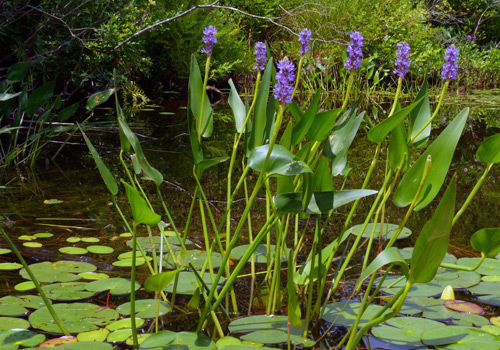Plant life can be beneficial for small ponds, but a thick overgrowth of more than 25% of aquatic plant life can seriously affect the life and use of the pond. Pond weed removal methods such as using a pond weed cutter can help manage weed overgrowth. Here are some ways aquatic plant overgrowth can be managed in small ponds and lakes.
Prevention
The best way to control plant life in small ponds is through preventative methods. Ponds constructed with deep wells and steeply sloping sides can keep weeds from taking root. Making the pond deep from the beginning can prevent the need for dredging the pond later. Also, in stream and river-fed ponds, a sediment basin located upstream, along with erosion protection, can keep the pond from filling with soil and reducing the depth. Fertilizer runoff is a major contributor to weed problems in small ponds. Fertilizing algae to prevent weeds only causes algae overgrowth. Sustainable agriculture practices that lessen the use of any fertilizer can help keep ponds from becoming overgrown with weeds.
Removal
Pond weed removal is another way to control pond aquatic plant overgrowth. Removal is primarily done with a pond weed cutter, which is a type of boat with pond removal equipment attached. They skim the top of the pond for weeds and aquatic vegetation, and some can even pull the weeds up from the roots for further prevention of overgrowth. A cutter will cut or pull up the weeds and gather them for removal. The removal must be done as thoroughly as possible to prevent regrowth. Aquatic cutters have the advantage of being less damaging to the ecology of the pond than some other methods like chemicals. As aquatic cutters only skim the top of the pond, they rarely damage fish and other beneficial aquatic life.
Biological
There are some biological methods to aquatic plant control that can be used in small ponds. Animals that eat aquatic plants, such as geese, swans, ducks, turtles, fish such as grass carp, and insects can be introduced into the pond to control aquatic plant life. This method can have advantages of being self-sustaining, but it is often difficult to implement and heavily regulated by state governments. Contacting your state department of game and fish can provide more information about biological pond weed control methods.
Chemical
One of the most common methods of controlling aquatic plants is chemical herbicides or poisons. The treatment process is often more simple than other methods. However, chemical herbicides have many disadvantages. Many herbicides will kill fish and other aquatic life in the pond. Herbicides can also prevent any use of the pond for some time, whether human recreation, fishing, agricultural use, drinking, or watering livestock. Herbicides can also be expensive and require regular applications to maintain weed control.
Conclusion
Contacting your local agricultural extension or department of game and fish can help you determine your options when planning a pond or faced with pond aquatic plant overgrowth. Finding a more sustainable method to control plant life, such as in the use of a pond weed cutter, may be a better investment in the long run for the life and health of your pond.
